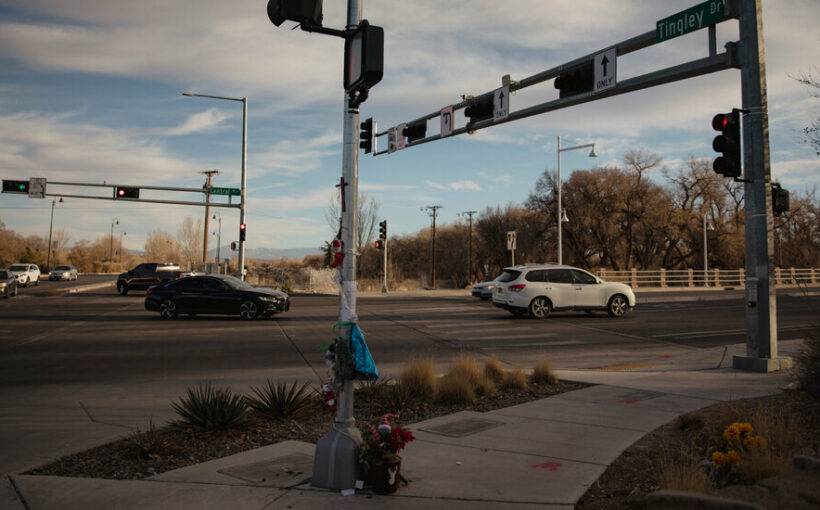The top federal auto safety regulator on Wednesday proposed requiring all new cars and trucks to have automatic braking systems that reduce the likelihood of collisions. The proposal comes after traffic fatalities and pedestrian deaths soared in recent years, topping 40,000 a year.
The plan from the National Highway Traffic Safety Administration would require car companies to expand the use of more advanced and powerful systems than those currently installed in some vehicles on the market. The agency is proposing that all light vehicles, which include cars as well as large pickup trucks and sport-utility vehicles, be equipped to automatically stop and avoid hitting pedestrians at speeds of up to 37 miles per hour.
Vehicles would also have to brake and stop to avoid hitting stopped or slow-moving vehicles at higher speeds. And the systems would have to perform well at night.
“We hope this will avoid many crashes,” Polly Trottenberg, a deputy transportation secretary, said at a news conference. “We know this is going to save lives.”
Ms. Trottenberg acknowledged the rule would impose costs on automakers, who have often resisted new safety standards. “I know we’re throwing a challenge out here, but we also know this technology is pretty well developed,” she said. “This is the time to take things to the next level.”
It is not exactly clear why traffic deaths have risen so much in recent years. But auto safety experts have pointed to several factors, including the larger size and weight of cars and trucks and greater distraction because drivers and pedestrians are increasingly using smartphones and other electronic devices. In some places, roads have been designed and lighted to keep traffic moving quickly rather than to protect pedestrians and cyclists.
The technology could help reduce fatal accidents.
Traffic fatalities are one of the most persistent causes of death in the United States, and they are increasing despite technological advances such as warning and crash avoidance systems, and increasing airbag use. Traffic deaths had been declining until about a decade ago, when they began rising rapidly. According to the traffic safety agency, 42,795 people died in auto crashes in 2022. That was down slightly from 2021, but 31 percent higher than in 2014.
The rise has been driven by a spike in pedestrian deaths. An estimated 3,500 pedestrians were killed in the first half of 2022, the most recent period for which data is available. That is a 5 percent increase from the same period in 2021 and the highest number in 40 years.
The toll goes beyond fatalities. In 2019, the economic cost of auto crashes totaled $340 billion, according to the safety agency. In that year, 36,500 people died in auto accidents, 4.5 million were injured and 23 million vehicles were damaged.
Government officials said the automatic-braking proposal could save at least 360 lives a year and reduce injuries by about 24,000 a year.
Braking systems use radar or cameras to anticipate accidents.
Automatic emergency braking systems typically use cameras, radar or both to spot vehicles, pedestrians, cyclists and other obstacles. By comparing a vehicle’s speed and direction with those of other vehicles or people, these systems can calculate when a collision appears imminent, alert the driver through an alarm and activate the brakes if drivers fail to do so.
The first of such systems were introduced in 2011. Five years later, automakers voluntarily agreed to make automatic emergency braking technology standard in all new cars and trucks by 2022. The agency said its proposed rule would impose higher standards on automatic braking than the technology automakers have voluntarily agreed to use.
Automatic braking is one component of advanced driver-assistance systems that are found in some new cars on sale today. These systems are capable of steering a vehicle without human intervention, and in some cases, changing lanes and allowing drivers to take their hands off the wheel for long stretches on highways. These include Tesla’s Autopilot system, Super Cruise by General Motors and BlueCruise from Ford Motor.
The federal safety agency has been investigating Tesla’s system after it appears to have failed to identify and spot other vehicles in some situations. The agency is looking at 43 crashes, including 14 in which 18 people were killed, that occurred while Autopilot or Tesla’s more advanced system, which the company calls Full Self-Driving, were activated.
It could take a few years before the rules go into effect.
The safety agency will take comments on the rule from automakers, safety advocates and the public before finalizing it — a process that can take a year or more. The rule will go into effect three yeas after it is adopted.
Neal E. Boudette is based in Michigan and has been covering the auto industry for two decades. He joined The New York Times in 2016 after more than 15 years at The Wall Street Journal. @nealboudette
Source: Read Full Article

